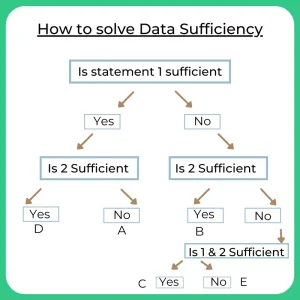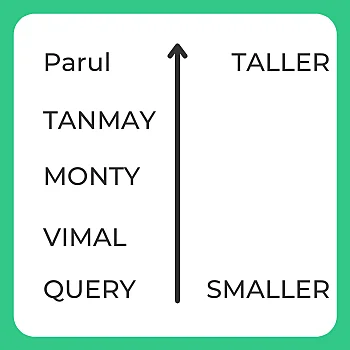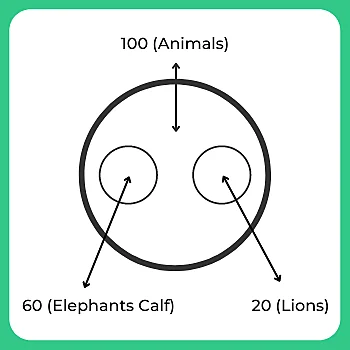Logical Menu
- Number Series
- Coding and Number Series
- Letter and Symbol Series
- Logical Sequence of Words
- Analogy and Classification Pattern
- Statements and Conclusions
- Statements and Assumptions
- Data Sufficiency
- Visual Reasoning
- Cube and Cuboid
- Cube
- Dice
- Directional Senses
- Blood Relations
- Odd Man Out
- Syllogism
- Arrangements
- Seating Arrangements
- Coding Deductive Logic
- Objective Reasoning
- Selection Decision Tables
- Attention to Details
- Inferred Meaning
- Cryprtarithmetic
- Get Off-campus Drive Updates
- Get Hiring Updates
- Contact US
PREPINSTA PRIME
How to Solve Data Sufficiency Problems Quickly
Solve Data Sufficiency Questions
This page here on provides information on How to Solve Data Sufficiency Problem Quickly.

How to Solve Data Sufficiency Rule 1:
- Analyse The Given Data. Don’t Jump Into It To Solve
Question 1.
What is Sapna’s rank in the class?
I. There are 35 students in the class.
II. There are 7 students who have scored less than Sapna.
A. if the data in statement I alone are sufficient to answer the question;
B. if the data in statement II alone are sufficient to answer the question;
C. if the data either in I or II alone are sufficient to answer the question;
D. if the data even in both the statement together are not sufficient to answer the question;
E. if the data in both the statements together are needed.
Answer: E
Explanation:
Out of 35 students 7 are behind of Sapna, means Sapna’s rank is 28th in the class. Hence both statements are required to solve this.
Question 2.
What day is the fifth of a given month?
I. Tuesday is the last day of the month.
II. The third Monday of the month was eighth.
A. if the data in statement I alone are sufficient to answer the question;
B. if the data in statement II alone are sufficient to answer the question;
C. if the data either in I or II alone are sufficient to answer the question;
D. if the data even in both the statement together are not sufficient to answer the question;
E. if the data in both the statements together are needed.
Answer: B
Explanation:
Statement 2 clearly answers that fifth day is Friday, hence option B is correct.
Question 3.
When can Hardeep get next flight for Rajkot from Delhi if it is 7.00 pm?
I. Flights for Rajkot leave after every 45 minutes, till 09 p.m.
II. Twenty-five minutes ago, one flight has left for Rajkot.
A. if the data in statement I alone are sufficient to answer the question;
B. if the data in statement II alone are sufficient to answer the question;
C. if the data either in I or II alone are sufficient to answer the question;
D. if the data even in both the statement together are not sufficient to answer the question;
E. if the data in both the statements together are needed.
Answer: E
Explanation:
By reading both the statements, it clearly represents that first flight left before 25 minutes only, hence the next flight will leave by 7.20 which can be identified by having both the options hence, option E is correct.
How to Solve Data Sufficiency Rule 2:
- Represent The Blood Relation Or Coding-Decoding Problems On Paper To Easily Process It
Question 4.
How is Beta related to Chitra?
I. Alpha and Beta are brothers and Chitra and Drishti are sisters.
II. Alpha’s son is Drishti’s brother.
A. if the data in statement I alone are sufficient to answer the question;
B. if the data in statement II alone are sufficient to answer the question;
C. if the data either in I or II alone are sufficient to answer the question;
D. if the data even in both the statement together are not sufficient to answer the question;
E. if the data in both the statements together are needed.
Answer: E
Explanation:
By using the above notations we can draw the below diagram. Alpha, Beta is taken ‘+’ and Chitra, Drishti is taken as ‘-’. It seems that Alpha, Beta belongs to one generation and Chitra, Drishti belongs to another generation.
So, Alpha, Beta is taken in one horizontal row and Chitra, Drishti is taken in another horizontal line. It says that Alpha is Chitra’s father. Father’s brother is an uncle. So, the answer is uncle.

Question 5.
What is the mathematical code for ‘coconut’ in a certain code?
I. The code for ‘give me coconut’ is ‘777’.
II. The code for ‘you can bring coconut for me’ is written as ‘673196’.
A. I alone is sufficient while II alone is not sufficient
B. II alone is sufficient while I alone is not sufficient
C. Either I or II is sufficient
D. Neither I nor II is sufficient
E. Both I and II are sufficient
Answer: D
Explanation:
Statement 1 and 2 both do not contain clear information to answer the code of coconut hence, option D is correct.
Give me coconut =777
You can bring coconut for me 673196
7 is common for coconut/me=? Cannot be determined
Question 6.
Who among Parul, Query, Tanmay, Vimal, and Monty is exactly in the center when they are in rising order of their heights?
I. Vimal is taller than Query but shorter than Monty.
II. Tanmay is taller than Query and Monty but shorter than Parul.
A. I alone is sufficient while II alone is not sufficient
B. II alone is sufficient while I alone is not sufficient
C. Either I or II is sufficient
D. Neither I nor II is sufficient
E. Both I and II are sufficient
Answer: Option E
Explanation:
Please refer to the diagram.

How to Solve Data Sufficiency Rule 3:
- Do Not Assume Anything By Your Own Knowledge. Make Assumptions With The Information Provided In The Given Statements
Question 7.
On which day in April is Rahul’s birthday?
I. Rahul was born exactly 30 years after his mother’s born.
II. His mother will be 50 years 5 months and 9 days on August 20 this year.
A. if the data in statement I alone are sufficient to answer the question;
B. if the data in statement II alone are sufficient to answer the question;
C. if the data either in I or II alone are sufficient to answer the question;
D. if the data even in both the statement together are not sufficient to answer the question;
E. if the data in both the statements together are needed.
Answer: E
Explanation:
Statement 1 and 2 both contain information to answer Rahul’s birthday hence, option E is correct.
Question 8.
How many guests saw the trade fair yesterday?
I. Up to three persons can enter having one entry pass with him/her.
II. Total, 333 passes were sold yesterday.
A. if the data in statement I alone are sufficient to answer the question;
B. if the data in statement II alone are sufficient to answer the question;
C. if the data either in I or II alone are sufficient to answer the question;
D. if the data even in both the statement together are not sufficient to answer the question;
E. if the data in both the statements together are needed.
Answer: D
Explanation:
Statement 1 and 2 both do not contain clear information to answer the number of guests, who saw the fair hence, option D is correct.
Question 9.
On Tuesday how many milk packets were sold?
I. It was 20% more than the milk packets sold on the earlier day i.e., Monday.
II. Every alternate visitor to the shop purchased the milk packets and 2500 visitors were there on Monday.
A. if the data in statement I alone are sufficient to answer the question;
B. if the data in statement II alone are sufficient to answer the question;
C. if the data either in I or II alone are sufficient to answer the question;
D. if the data even in both the statement together are not sufficient to answer the question;
E. if the data in both the statements together are needed.
Answer: E
Explanation:
Statement 1 and 2 both contains information to answer the number of milk packets sold i.e. 1500 hence, option E is correct.
How to Solve Data Sufficiency Rule 4:
- Practice Venn Diagrams As Much As You Can
Question 10.
Out of the 100 animals in the Omaha zoo, how many are lions?
I. 60 of 100 are newly born elephants (Calf).
II. 20 animals out of 40 are not elephant but a lion.
A. I alone sufficient while II alone not sufficient to answer.
B. II alone sufficient while I alone not sufficient to answer.
C. Either I or II alone sufficient to answer.
D. Both I and II are not sufficient to answer.
E. Both I and II are necessary to answer.
Answer: D
Explanation:
As we see in the Venn diagram, statement A gives information about 60 baby elephants out of a total of 100 animals. Further statement B talks about 20 animals that are a lion but does not give information about the remaining 20. They may be a lion or any other animal also. Hence both the statements are not capable to provide an exact number of lions. Thus option D is correct.

Question 11.
There are 60 children admitted to a Music Academy. Some children can play only Guitar and some can play only Sitar. How many children can only play Sitar?
I. 15 children can play both Guitar and Sitar
II. The total number of children who can play Guitar is 27
A. if the data in statement I alone are sufficient to answer the question;
B. if the data in statement II alone are sufficient answer the question;
C. if the data either in I or II alone are sufficient to answer the question;
D. if the data even in both the statements together are not sufficient to answer the question;
E. If the data in both the statements together are needed.
Answer: E
Explanation:
Statement 1 gives information about common students for Guitar and Sitar. Now, statement 2 talks about the total number of children who can play Guitar is 27. Thus by using both the statements, we can conclude that:
27 – 15 = 12 children can only play Guitar; 60 – 12 = 48 children can play Sitar
Student for only sitar=48 – 15 = 33
Hence 33 students can only play Sitar which comes from both the statements. Hence option E is correct.

Prime Course Trailer
Related Banners
Get PrepInsta Prime & get Access to all 200+ courses offered by PrepInsta in One Subscription
Also Check Out:
Get over 200+ course One Subscription
Courses like AI/ML, Cloud Computing, Ethical Hacking, C, C++, Java, Python, DSA (All Languages), Competitive Coding (All Languages), TCS, Infosys, Wipro, Amazon, DBMS, SQL and others
- Statements and Conclusions – Questions | Formulas | How to Solve Quickly | Tricks & Shortcuts
- Statements and Assumptions – Questions | Formulas | How to Solve Quickly | Tricks & Shortcuts
- Statements and Conclusions – Questions |
Formulas |
How to Solve Quickly |
Tricks & Shortcuts - Statements and Assumptions – Questions |
Formulas |
How to Solve Quickly |
Tricks & Shortcuts

 Apply For Jobs
Apply For Jobs Get Hiring Updates
Get Hiring Updates



